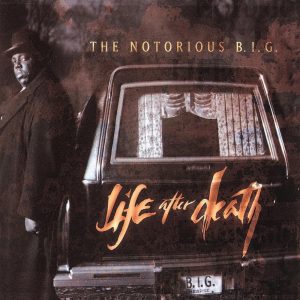
Category: Album
Title: Life After Death
Artist: Notorious B.I.G.
Features: 112, Angela Winbush, Bone Thugs-n-Harmony, DMC, Jay-Z, Lil' Kim, Mase, Puff Daddy, R. Kelly, The LOX, Too Short
Released: March 25, 1997.
Genres: East Coast Hip-Hop, Gangsta Rap, Hip-Hop
Album Background
Release Date and Label
Life After Death was released on March 25, 1997, by Bad Boy Records. This album was Biggie’s second and final studio album, released just 16 days after his tragic death in a drive-by shooting in Los Angeles. The album was highly anticipated and is considered one of the greatest hip-hop albums of all time.
Artist Context
At the time of creating Life After Death, The Notorious B.I.G. was at the peak of his career. His debut album, Ready to Die, had already established him as a leading figure in the hip-hop world. Life After Death was meant to solidify his dominance in the genre and expand his reach into the mainstream, showcasing his versatility and growth as an artist.
Concept and Inspiration
Themes and Messages
The album explores themes of mortality, fame, violence, wealth, and power. It reflects on the consequences of the lifestyle Biggie rapped about in his debut album, with a mix of reflective tracks and party anthems. The title Life After Death itself is a stark commentary on the fragile line between life and death, especially poignant given Biggie’s untimely demise.
Inspiration
Biggie’s inspiration for the album came from his own life experiences, the success he had achieved, and the challenges that came with fame. The East Coast-West Coast rivalry and the escalating tensions in the rap community also influenced the darker tones of the album. His lyrics often reflect a sense of foreboding and the realization of the dangers that come with his newfound status.
Writing and Recording Process
Songwriting and Recording
The songwriting process for Life After Death was extensive, with Biggie focusing on crafting songs that showcased his storytelling abilities, lyrical dexterity, and broader appeal. The recording sessions took place over several months, and the album was primarily recorded at Daddy’s House Recording Studio in New York City, with additional sessions in Los Angeles.
Notable Collaborations
The album features a host of high-profile collaborations, including Jay-Z, Puff Daddy, Bone Thugs-n-Harmony, Lil’ Kim, 112, R. Kelly, and The LOX. These collaborations added diversity to the album’s sound and helped to cement Biggie’s status as a heavyweight in the hip-hop industry.
Production Details
Producers and Sound
-
- Sean “Puffy” Combs: Puffy was the executive producer of the album and played a key role in shaping its sound, aiming for a balance between gritty street narratives and crossover appeal.
- The Hitmen: The production team known as The Hitmen, including Stevie J, Deric “D-Dot” Angelettie, and Nashiem Myrick, contributed significantly to the album’s polished, cinematic sound.
- Sound and Musical Style: The album is known for its blend of hardcore hip-hop with mainstream elements, including smooth R&B hooks, dark beats, and lush instrumentation. It incorporates elements of gangsta rap, but also explores more commercial sounds, making it accessible to a broader audience.
Track-by-Track Analysis
-
Track Listing:
- Disc One:
- “Life After Death (Intro)”
- “Somebody’s Gotta Die”
- “Hypnotize”
- “Kick in the Door”
- “Fuck You Tonight” (featuring R. Kelly)
- “Last Day” (featuring The LOX)
- “I Love the Dough” (featuring Jay-Z and Angela Winbush)
- “What’s Beef?”
- “B.I.G. Interlude”
- “Mo Money Mo Problems” (featuring Puff Daddy and Mase)
- “Niggas Bleed”
- “I Got a Story to Tell”
- Disc Two:
- “Notorious Thugs” (featuring Bone Thugs-n-Harmony)
- “Miss U”
- “Another” (featuring Lil’ Kim)
- “Going Back to Cali”
- “Ten Crack Commandments”
- “Playa Hater”
- “Nasty Boy”
- “Sky’s the Limit” (featuring 112)
- “The World Is Filled…” (featuring Too Short and Puff Daddy)
- “My Downfall” (featuring DMC)
- “Long Kiss Goodnight”
- “You’re Nobody (Til Somebody Kills You)”
- Disc One:
-
Key Tracks:
- “Hypnotize”: One of Biggie’s biggest hits, “Hypnotize” features a catchy, infectious beat and showcases Biggie’s smooth, effortless flow. It became a number one hit and is one of his most recognizable songs.
- “Mo Money Mo Problems”: Another chart-topping single, this track features Puff Daddy and Mase. It combines a celebratory vibe with a reflection on the downsides of wealth and fame.
- “Ten Crack Commandments”: This track is a guide to surviving the drug trade, presented with a hard-hitting beat and Biggie’s signature storytelling style. It’s one of the more introspective and cautionary tracks on the album.
- “Notorious Thugs”: Featuring Bone Thugs-n-Harmony, this track is a highlight for its rapid-fire delivery and blending of East Coast and Midwest styles, demonstrating Biggie’s versatility.
Awards and Nominations
Awards and Nominations
Life After Death received several nominations and won numerous awards, including nominations at the Grammy Awards for Best Rap Album and Best Rap Solo Performance for “Hypnotize.” The album and its singles dominated the music awards circuit in the late 1990s.
Sales and Charts
Billboard 200: The album debuted at No. 1 on the Billboard 200 chart and remained there for four consecutive weeks.
RIAA Certifications: The album was certified Diamond by the RIAA, signifying sales of over 10 million copies in the United States alone. It has been certified multi-Platinum in several other countries as well, making it one of the best-selling hip-hop albums of all time.
Impact and Legacy
Influence and Long-term Impact
Life After Death is considered a defining moment in hip-hop history. It solidified The Notorious B.I.G.’s legacy as one of the greatest rappers of all time and influenced countless artists in the years that followed. The album’s success helped to bridge the gap between hardcore hip-hop and mainstream music, making Biggie a household name even beyond the hip-hop community.
The album also played a significant role in shaping the sound of late 1990s hip-hop, with its polished production and commercial appeal influencing the direction of the genre.
Conclusion
Summary
Life After Death is a monumental album that captures The Notorious B.I.G. at the height of his powers. It’s a fitting swan song for an artist whose impact on hip-hop is still felt today. The album’s combination of hard-hitting tracks and mainstream hits ensured its place in music history, and it continues to be celebrated as a classic.
Final Thoughts
Life After Death stands as a testament to Biggie’s incredible talent and his ability to craft songs that resonate on multiple levels. The album’s wide-ranging themes, from the perils of street life to the luxuries of success, make it a rich, complex work that remains relevant. It’s an essential listen for anyone interested in the evolution of hip-hop and the enduring legacy of one of its greatest icons.













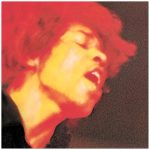
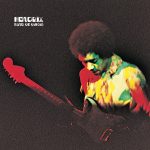
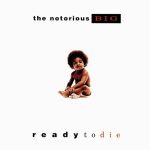
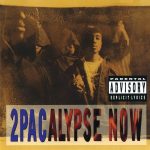

Leave a Reply